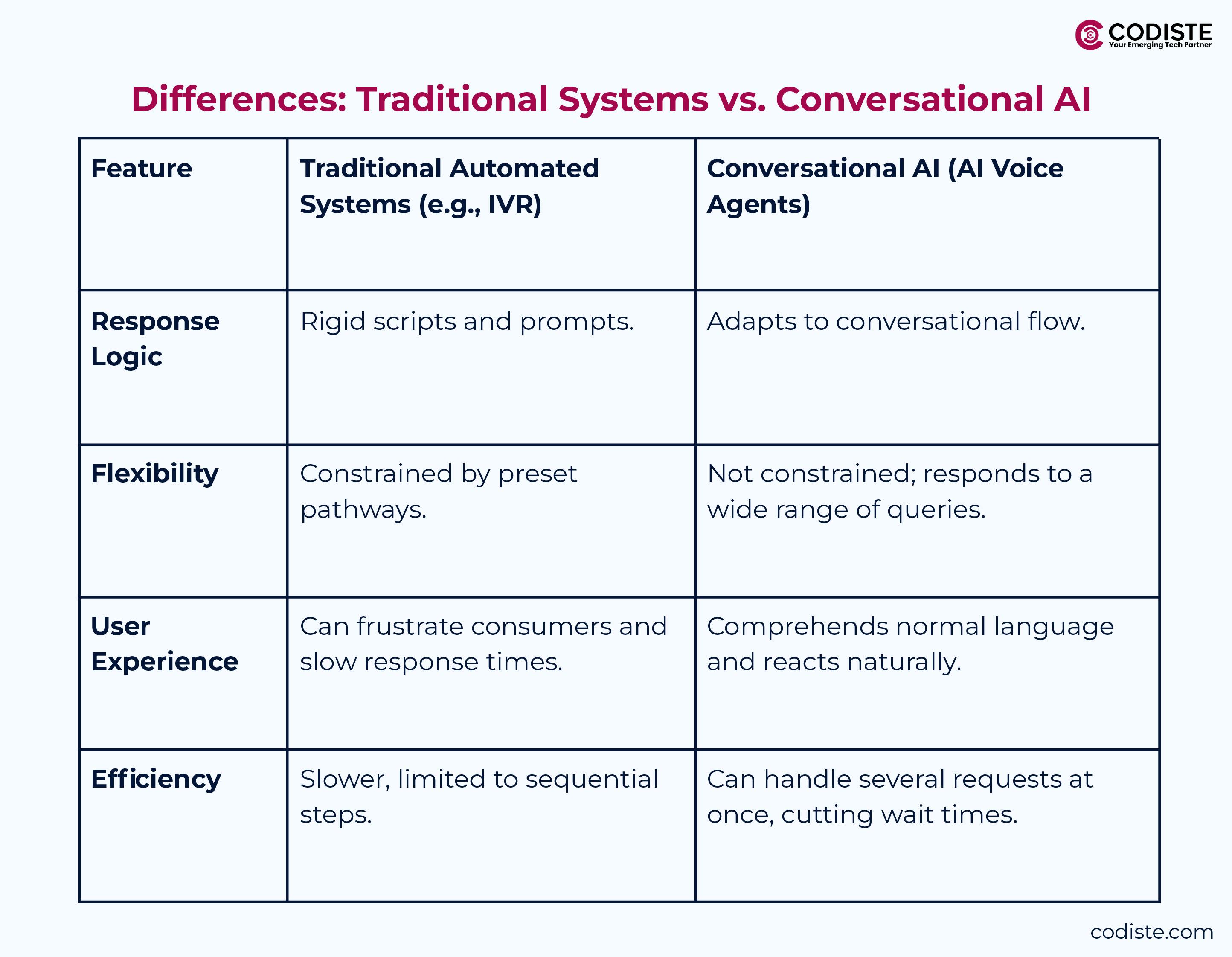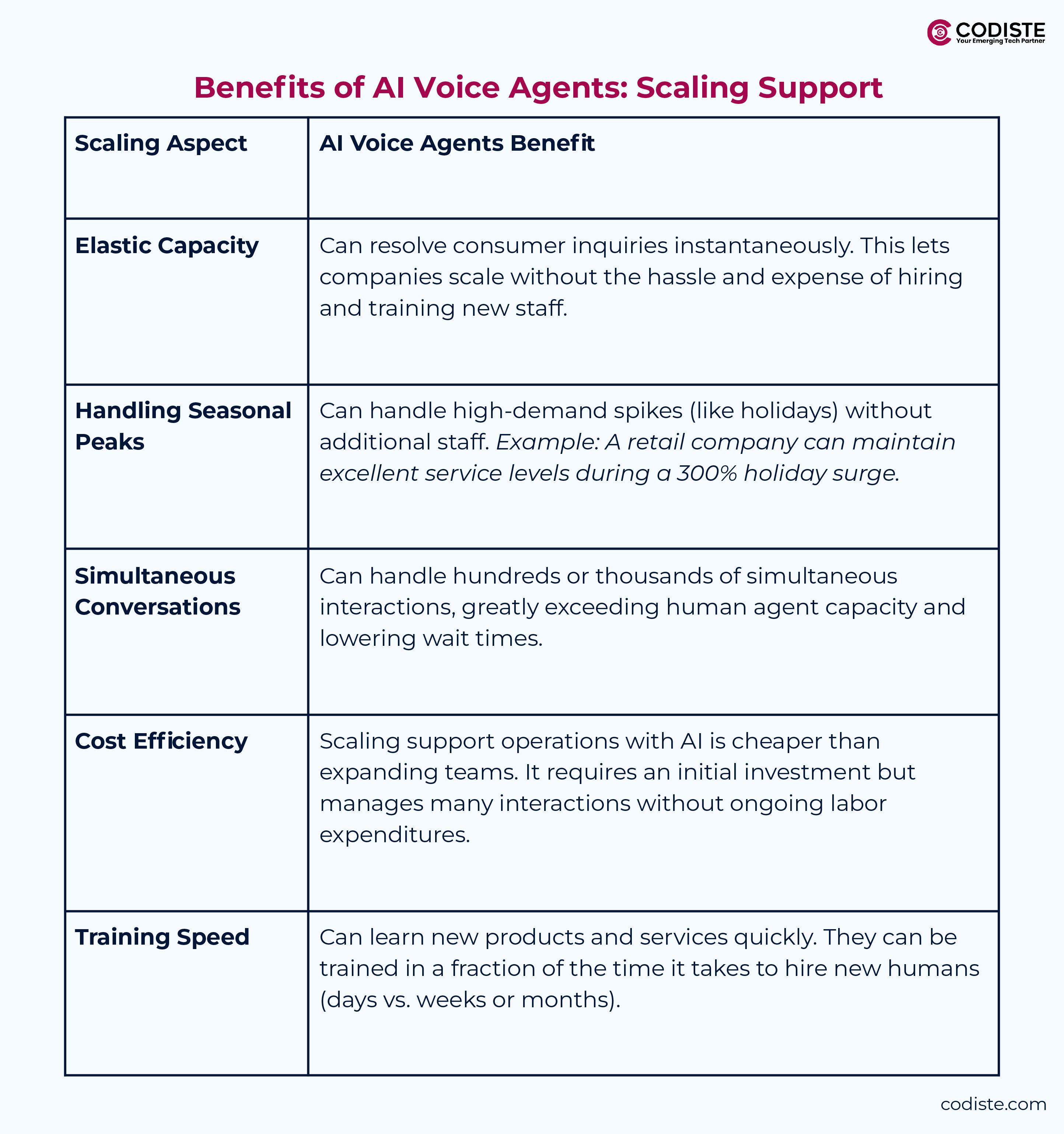
,
Businesses are encountering difficulties in scaling customer service in today's rapidly evolving digital ecosystem. Companies often struggle to deliver the quality of service that clients demand while dealing with rising call volumes, labor shortages, and financial strains. More than 70% of consumers now anticipate prompt answers to their questions. There is also an increasing need for round-the-clock accessibility, per recent surveys.
Client expectations have changed. It is now critical for firms to find creative ways to satisfy these demands without using up all of their resources. Here comes AI voice agents, a game-changing tool. This tool improves customer satisfaction while simultaneously relieving the strain on customer service representatives.
With AI in customer support, businesses can optimize operating costs. They ensure prompt and effective responses to client interactions around the clock by utilizing cutting-edge AI technology. This blog will examine how an AI voice assistant for business will help transform customer service and facilitate easy business scaling.
What Are AI Voice Agents and How Do They Work?
AI voice agents use sophisticated conversational interfaces to communicate with users via voice commands. They utilize Natural Language Processing (NLP) and Machine Learning (ML) for customer service. These intelligent systems simulate human-like interactions. They perform a range of customer support duties, including answering questions, giving information, and carrying out actions. They are made to comprehend, interpret, and react to human speech.
How AI Voice Agents Work
These smart voice agents use a systematic workflow that includes several crucial elements:
- Voice Recognition: The AI voice agent records the audio input when a user speaks into a device. An Automated Speech Recognition (ASR) system subsequently processes this audio input, turning the spoken words into text.
- Intent Identification: The transcribed text is analyzed using Natural Language Understanding (NLU), a subset of NLP. This stage is figuring out the customer's goal, or what they are attempting to achieve or request. Example: The system recognizes a consumer is requesting order information when they ask, "What is the status of my order?"
- Information Retrieval: The AI speech agent retrieves pertinent information after determining the goal. This data comes from databases or integrated knowledge bases. It can include order details, client account information, or answers to commonly asked queries.
- Response Generation: Once the required data has been retrieved, the AI uses a Large Language Model (LLM) to respond. This guarantees a competent, contextually relevant, and unambiguous reply. Example: The agent may reply, "Your order is currently being processed and will ship by tomorrow."
- Voice Output: Lastly, a Text-to-Speech (TTS) system transforms the generated text response back into speech. The synthesized voice completes the interaction in a natural-sounding way by playing back to the client.
In conclusion, these smart voice agents enable 24/7 help, reduced wait times, and personalized experiences. They improve the customer experience by reading client questions, obtaining relevant information, and reacting in a natural, conversational manner using advanced NLP and ML.
The Evolution of Customer Support Technology
The advancement of customer support technology has been both exciting and revolutionary. It has moved from a basic contact center to an intelligent AI voice assistant for 24/7 support, capable of carrying on natural conversations.
From Call Centers to AI Voice Agents
- Early Call Centers: Customers were first supported here, with workers answering questions. This method was overloaded as firms developed and phone volumes increased.
- IVR Systems (1980s-1990s): Companies implemented Interactive Voice Response (IVR) systems to streamline operations. These systems provide basic support without a live representative, using pre-recorded menus. The rigidity and inability to understand complicated queries of these systems often upset users.
Modern AI Voice Agents: Technology now makes AI voice agents possible. ML and NLP let current solutions comprehend and respond to consumer inquiries more naturally. AI voice assistants transform customer service. They can answer many queries, learn from interactions, and provide personalized support.

Why Adoption of Voice AI Is Critical Right Now
The current environment makes the deployment of speech AI technologies crucial. The following elements add to this urgency:
- Rising Customer Expectations: Customers are calling for more prompt, effective, and round-the-clock assistance. AI voice agents can easily match these expectations.
- Advancements in Technology: AI speech bots are now more reliable and efficient than ever. This is thanks to significant advancements in ML and NLP.
- Cost-Effectiveness: Businesses must maintain good service standards while cutting operational costs. Smart voice agents provide a solution that can greatly reduce expenses while improving assistance skills.
AI speech technology adoption is becoming essential for companies looking to prosper in a cutthroat market. This helps them negotiate the complexity of contemporary customer demands.
Core Benefits of AI Voice Agents: Scaling Support
AI voice agents solve high call volumes and personnel shortages, revolutionizing customer care. Here is how AI helps support teams scale:

Key Features That Drive Support Efficiency
1. Natural Language Processing for Understanding Customer Intent
NLP is the key technology that lets AI speech agents understand human language. NLP helps agents grasp client intent from casual or incorrect spoken requests. Customers can communicate their wants in their own words, making interactions more genuine. Businesses can answer questions faster and more precisely, improving consumer satisfaction.
2. Sentiment Analysis to Detect Customer Emotions
Sentiment analysis is a key function. It helps AI voice operators assess client emotions. AI can assess if client queries are positive, negative, or neutral. This allows them to personalize responses. If a customer is frustrated, the AI can escalate to a human agent or show empathy, improving the experience. This capacity improves customer service and personalizes interactions.
Read more: Sentiment Analysis in ML : Algorithms and Applications Defined!
3. Integration with CRM and Knowledge Base Systems
AI voice assistants obtain real-time customer data and information by seamlessly integrating with Customer Relationship Management (CRM) and knowledge libraries. This integration lets agents personalize responses based on customer history, preferences, and engagements. With immediate access to this information, AI voice assistants address issues faster and make consumers feel appreciated.
4. Automatic Ticket Creation and Routing
AI voice agents automatically create support tickets. They route these tickets to the right department or agent for customer inquiries. This automation speeds up support, reducing resolution time. Businesses can improve response times and customer satisfaction by categorizing and prioritizing tickets by urgency.
5. Conversation Summarization for Complex Cases
When humans are needed, AI voice agents can summarize conversations. A brief review of the interaction history highlights crucial topics and consumer sentiments. Organizations can shorten onboarding time and help agents comprehend the issue by giving them this information. This speeds up, resolves and improves AI-human support.
Read more: How AI Voice Agents Are Revolutionizing Customer Support
Implementation Strategies for Success
Choosing use cases and ensuring a smooth transition are essential to incorporating AI voice agents into a business. Effective implementation tactics include:
- Start with Specific Use Cases: Begin with select use cases that can bring immediate value rather than replacing all customer support functions. Identify high-impact areas like FAQs, appointment scheduling, and first-tier support to pilot the technology. This avoids disturbance and reveals how to optimize the AI for larger uses.
- Train AI on Company-Specific Knowledge: AI voice agents must be trained on company-specific terms to operate well. The collection must include common consumer inquiries, industry lingo, and internal processes. Providing this personalized data improves AI replies and ensures operators understand consumer interactions. Regular updates and training will enable the AI to adapt to changes.
- Create Clear Escalation Paths: Some circumstances require human assistance. Customer satisfaction requires clear escalation pathways to human agents. If an AI detects frustration or encounters hard questions, it should smoothly transfer the call. This smooth transition allows firms to use both AI and human agents to give better service.
- Continuous Improvement Through Conversation Analysis: Companies should use conversation analysis to improve AI voice agents. Frequently assessing customer-AI interactions helps identify issues like misunderstandings and knowledge gaps. Analyzing the AI's training data and conversation patterns helps the agent improve at managing client inquiries.
Future Trends in AI Voice Support
1. Increasingly Sophisticated Emotional Intelligence
Emotional intelligence will advance in AI voice support. Advanced AI systems can recognize and analyze customers' voice tone, pitch, and tempo. AI voice assistants can adapt their tone and responses to customers' emotions. Example: In response to client displeasure, the AI can calmly reassure the customer, improving the engagement. Increasing emotional intelligence will make human-machine interactions more natural and supportive.
2. Proactive Outreach Capabilities
AI voice operators are becoming proactive. They anticipate client needs and initiate interactions before customers do. Example: An AI voice agent may remind a customer of an appointment, propose a follow-up, or prevent difficulties from escalating. This proactive strategy improves customer satisfaction by offering quick support and shows brand concern. AI can forecast customer behavior and preferences using data analytics and ML.
3. Seamless Handoffs Between AI and Human Agents
The seamless handoff will be crucial as AI voice technology matures. AI will seamlessly shift the conversation to a human agent when an issue requires human assistance, providing context and relevant information. This eliminates client repetition, improving efficiency and satisfaction. Businesses boost customer loyalty by keeping discussions consistent.
4. Voice Biometrics for Authentication
Voice biometrics for authentication is another future trend. This system uses distinctive speech qualities to authenticate users securely and conveniently. Customers might make purchases or access critical data without passwords or PINs, using their voices. This reduces authentication friction, improving security and consumer experience.
Human-like AI agents to reduce client waiting periods.
Conclusion
AI voice agents enable scalable, efficient, and responsive customer support, revolutionizing it. By automating typical questions and offering fast responses, these intelligent tools help firms satisfy consumer demands while optimizing resources. Users enjoy faster resolutions and individualized interactions with AI voice operators. This improves operational efficiency and customer satisfaction.
Now is the moment to assess business needs and adopt these AI voice technologies for customer assistance. Assess support processes, identify improvement opportunities, and consider adding AI voice agents. By being proactive, firms can satisfy changing client expectations and stay ahead of the competition.
Moving forward, we foresee a human-AI support ecosystem. AI voice assistants for business will work together with human agents. AI handles routine chores and early support, letting human agents focus on complicated issues that demand empathy, creativity, and critical thinking.
By investing in AI customer service solutions, businesses can prosper in a digital age and provide great service that combines technology and the human touch. To solve this challenge, you need a robust AI voice agent that can be AI and still feel human. To your surprise, we got you covered. With Codiste’s AI voice development services, you can sit back and relax while we do the heavy lifting for you. Get a free





